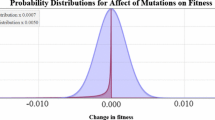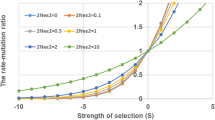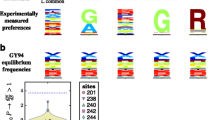Abstract
Genetic systems are complex and interact at various levels; among amino acids or nucleotide sites, among gene products, and among regulatory regions and proteins. Patterns of synonymous and nonsynonymous substitutions of mammalian genes indicate that nonsynonymous substitutions are nearly neutral, coming from interactions among amino acids. As an interactive system, the NK model of Kauffman was analysed. This model assumes that each amino acid makes a fitness contribution that depends upon the amino acid and upon K other amino acids among the N that make the protein. Through simulations, it was found that there are numerous nearly-neutral mutations in this model, and that evolution is rapid in small populations and slow in large ones. The system moves on the rugged fitness landscape by mutation, random genetic drift and selection. Small populations have more chance to attain novel genetic systems than large ones because of larger effects of random drift, but the chance of extinction becomes greater.
Similar content being viewed by others
References
Akashi, H., 1995. Inferring weak selection from patterns of polymorphism and divergence at ‘silent’ sites in Drosophila DNA. Genetics 139: 1067-1076.
Araki, H., & H. Tachida, 1997. Bottleneck effect on evolutionary rate in the nearly neutral mutation model. Genetics 147: 907-914.
Ballard, J.W.O. & M. Kreitman, 1994. Unraveling selection in the mitochondrial genome of Drosophila. Genetics 138: 757-772.
Bernardi, G., 1989. The isochore organization of the human genome. Ann. Rev. Genet. 23: 637-661.
Bernardi, G., 1995. The human genome: organization and evolutionary history. Ann. Rev. Genet. 29: 445-476.
Bulmer, M., 1991. The selectionmutationdrift theory of synonymous codon usage. Genetics 129: 897-907.
Chao, L. & D.E. Carr, 1993. Themolecular clock and the relationship between population size and generation time. Evolution 47: 688-690.
Eanes, W.F., M. Kirchner & J. Yoon, 1993. Evidence for adaptive evolution of the G6pd gene in the Drosophila melanogaster and Drosophila simulans lineages. Proc. Natl. Acad. Sci., USA 90: 7475-7479.
Gardiner, K., 1995. Human genome organization. Current Opinion in Genetics and Development 5: 315-322.
Gillespie, J.H., 1984. Molecular evolution over the mutational landscape. Evolution 38: 1116-1129.
Gillespie, J.H., 1991. The Causes of Molecular Evolution. Oxford Univ. Press, Oxford.
Gould, S.J. & N. Eldredge, 1977. Punctuated equilibria: the tempo and mode of evolution reconsidered. Paleobiology 3: 115-151.
Holmquist, G., 1992. Reviewarticle: Chromosome bands, their chromatin flavors and their functional features. Am. J. Hum. Genet. 51: 17-37.
Ina, Y., 1995. New methods for estimating the numbers of synonymous and nonsynonymous substitutions. J. Mol. Evol. 40: 190-226.
Kauffman, S.A., 1993. The Origins of Order. Oxford Univ. Press, Oxford.
Keightley, P.D., 1994. The distribution of mutation effects on viability in Drosophila melanogaster. Genetics 138: 1315-1322.
Kimura, M., 1979. Amodel of effectively neutral mutations in which selective constraint is incorporated. Proc. Natl. Acad. Sci., USA 76: 3440-3444.
Kimura, M., 1983. The Neutral Theory of Molecular Evolution. Cambridge Univ. Press, Cambridge.
Kondrashov, A., 1995. Contamination of the genome by very slightly deleterious mutations: Why have we not died 100 times over? J. Theor. Biol. 175: 583-594.
Li, W.-H., 1979. Maintenance of genetic variability under the pressure of neutral and deleterious mutations in a finite population. Genetics 92: 647-667.
Long, M. & C.H. Langley, 1993. Natural selection and the origin of jingwei, a chimeric processed functional gene in Drosophila. Science 260: 91-95.
McDonald, J.H. & M. Kreitman, 1991. Adaptive protein evolution at the Adh locus in Drosophila. Nature 351: 652-654.
Miyashita, N.T., H. Innan & R. Terauchi, 1996. Intraand interspecific variation of alcohol dehydrogenase locus region in wild plants Arabis gemmifera and Arabidopsis thaliana. Mol. Biol. Evol. 13: 433-436.
Mukai, T., 1964. The genetic structure of natural populations of Drosophila melanogaster. I. Spontaneous mutation rate of polygenes controlling viability. Genetics 50: 1-19.
Nachman, M.W., S.N. Boyer & C.F. Aquadro, 1994. Nonneutral evolution at the mitochondrial NADH dehydrogenase subunit 3 gene in mice. Proc. Natl. Acad. Sci., USA 91: 6364-6368.
Nachman, M.W., W.M. Brown, M. Stoneking & C.F. Aquadro, 1996. Nonneutral mitochondrial DNA variation in humans and chimpanzees. Genetics 192: 953-963.
Ohta, T., 1973. Slightly deleteriousmutant substitutions in evolution. Nature 246: 96-98.
Ohta, T., 1977. Extension to the neutral mutation random drift hypothesis, pp. 148-167. Kimura M (ed) Molecular Evolution and Polymorphism, edited by M. Kimura. National Institute of Genetics, Mishima.
Ohta, T., 1992a. The nearly neutral theory of molecular evolution. Ann. Rev. Ecol. Syst. 23: 263-286.
Ohta, T., 1992b. The meaning of natural selection revisited at the molecular level. Trends in Ecol. Evol. 7: 311-312.
Ohta, T., 1995. Synonymous and nonsynonymous substitutions in mammalian genes and the nearly neutral theory. J. Mol. Evol. 40: 56-63.
Ohta, T., 1997. Role of random genetic drift in the evolution of interactive systems. J. Mol. Evol. 44: S9-S14.
Ohta, T. & H. Tachida, 1990. Theoretical study of near neutrality. I. Heterozygosity and rate of mutant substitution. Genetics 126: 219-229.
Rand, D.M. & L.M. Kann, 1996. Excess amino acid polymorphism in mitochondrial DNA: Contracts among genes from Drosophila, mice, and humans. Mol. Biol. Evol. 13: 735-748.
Sharp, P. &W.-H. Li, 1989. On the rate of DNA sequence evolution in Drosophila. J. Mol. Evol. 28: 398-402.
Tachida, H., 1991. A study on a nearly neutral mutation model in finite populations. Genetics 128: 183-192.
Tachida, H., 1996. Effects of the shape of distribution of mutant effect in nearly neutral mutation models. Jour. Genet. 75: 33-48.
Tajima, F., 1989. Statistical method for testing the neutral mutation hypothesis by DNA polymorphism. Genetics 123: 585-595.
Throckmorton, L.H., 1975. The phylogeny, ecology and geography of Drosophila, pp. 421-469. King RC (ed) Handbook of Genetics vol. 3, edited by R.C. King. Plenum Press, New York.
Wright, S., 1932. The roles of mutation, inbreeding, crossbreeding and selection in evolution. Proceedings of the Sixth International Congress of Genetics, 1: 356-366.
Wright, S., 1982. The shifting balance theory and macroevolution. Annual Review of Genetics 16: 1-19.
Zuckerkandl, E., 1997. Neutral and nonneutral mutations: the creative mix in gene interactive systems. J. Mol. Evol. 44: S2-S8.
Author information
Authors and Affiliations
Rights and permissions
About this article
Cite this article
Ohta, T. Evolution by nearly-neutral mutations. Genetica 102, 83–90 (1998). https://doi.org/10.1023/A:1017007513825
Issue Date:
DOI: https://doi.org/10.1023/A:1017007513825




